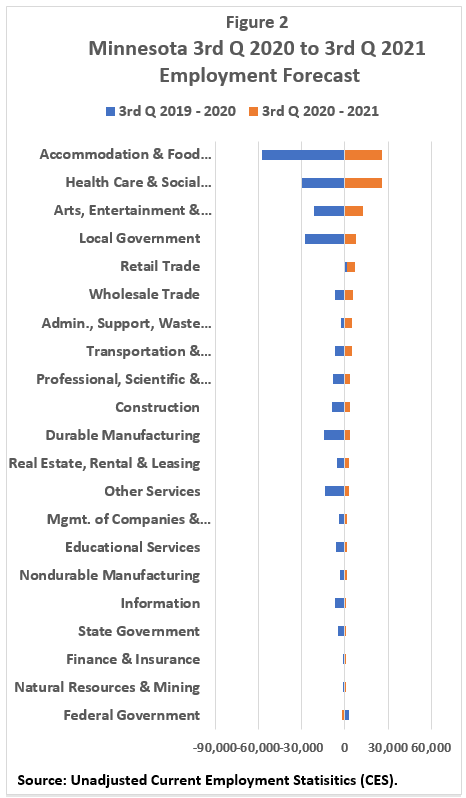
by Dave Senf
December 2020
Minnesota’s short-term jobs forecast is linked to the trajectory of the coronavirus and the size of any future round of federal stimulus. Job growth is expected to slow over the coming months and a recovery of all jobs lost is not projected to be reached until late 2022 or early 2023.
Minnesota, as of October, had recovered 52.5% of the wage and salary jobs lost in March and April when parts of Minnesota’s economy were temporarily closed to contain the spread of the virus that causes COVID-19. The job rebound began in May as the economy reopened and has continued over the past six months, but the pace has slowed over the last few months (see Figure 1). A slight recent uptick in initial claims for unemployment benefits after five months of steady decline points towards job growth slowing even further. Weekly initial claims levels remain nearly four times higher than pre-pandemic levels.

Minnesota’s bumpy labor market recovery is now facing new headwinds with the dramatic flare up of COVID-19 cases in November leading to a second temporary closing of inside dining, entertainment venues and fitness centers to slow the spread of the virus. A seasonally adjusted decline in employment during some months this winter would not be a surprising outcome of the ongoing spike in cases and hospitalizations.
Another developing headwind for job growth in the state in the near term is the tailing off of federal government pandemic relief spending. During the second quarter, pandemic relief spending, primarily in the form of expanded unemployment insurance checks and the one-time stimulus checks, boosted personal income in Minnesota as the recession set in in April, helping to keep consumer spending from dipping. Usually income growth slips sharply when a recession arrives, creating a self-feeding cycle of falling income leading to consumer spending cutbacks.
Job growth in the state over the next year will be, as it has been since the pandemic arrived, heavily influenced by the path of the pandemic and the size of any future round of federal pandemic relief spending. Underlying the third quarter 2020 to third quarter 2021 job forecast presented here are these assumptions:1
Based on the above assumptions, Minnesota is forecasted to add roughly 116,000 jobs between the third quarters of 2020 and 20212. The 4.2% increase averages out to 9,700 jobs per month, which is a third of the average pace achieved between May and October this year. Slower growth is expected over the next few months given the increase in social distancing, voluntary or state prompted, in response to the COVID spike. Job expansion is expected to accelerate during the second and third quarters of 2021 as cases recede and vaccine availability begins to expand.
Job growth for the most part will continue to be concentrated in sectors that were hardest hit earlier this year as the pandemic developed (see Figure 2). The biggest job gains are expected to be in Accommodation and Food Services and in Health Care and Social Assistance. Arts, Entertainment and Recreation along with Local Government will also see significant job rebound. The rate of job recovery across sectors will be uneven as social distancing continues to disrupt face-to-face services more so than industries with less direct consumer interaction. All sectors except for Federal Government employment are expected to see job growth over the next 12 months - Federal Government payrolls will shrink as Census-related positions are scaled back.

Job growth will not be robust enough over the next year to bring total employment back to the pre-pandemic level of the third quarter of 2019. The forecasted job total will leave the state’s employment about 3.6% below the third quarter of 2019. Complete recovery of all jobs lost during the pandemic – since first quarter 2020 - is not expected until sometime at the end of 2022 or beginning of 2023 as the pandemic’s grip on everyday life fades away.
Employment in the third quarter of 2021 is expected to top third quarter 2019 levels in only two sectors, Retail Trade and Administrative Support and Waste Management and Remediation Services. Payroll numbers in Administrative and Support Services is expected to experience robust expansion in the summer and fall of 2021 as Employment Services (also known as temp agencies or staffing agencies) ramp up to meet accelerating labor demand. The sectors expected to be down the most from pre-pandemic levels in 3rd quarter 2021 include Natural Resources and Mining; Information; Arts, Entertainment and Recreation; Accommodation and Food Services; and Other Services.
The usual uncertainties of the trajectory of the economy during any economic recovery are magnified by the uncertainty of the timing and effectiveness of vaccines in containing the coronavirus sometime in 2021. The forecast presented here starts with the baseline (deemed the most likely to occur) scenario from IHS Markit for November. Their baseline forecast is given a 50% percent chance of occurring versus their optimistic and pessimistic scenarios (which each have a 25% chance of occurring). IHS and DEED analysts also provided a pessimistic scenario where the upturn in new COVID cases, hospitalizations and deaths stays elevated well into 2021, temporary business closings are extended, and the promise of rapid deployment of effective vaccines is delayed.
Under the pessimistic scenario job growth over the next 12 months falls to 2.8% over the year as hiring slows significantly across many sectors, with job rebound delayed the most in these sectors: Health Care and Social Assistance; Accommodation and Food Service; Arts, Entertainment and Recreation: Local Government; and Durable Goods Manufacturing.
The bottom line of the third quarter jobs forecast is that job growth is expected to slow further over the next few months as the course of the COVID-19 pandemic still determines the course of Minnesota’s job rebound. Job growth will speed up in the second and third quarters of 2021 as favorable therapeutics and vaccine developments provide much-needed relief from the pandemic.
1The forecast presented here starts with the November baseline forecast of IHS Markit, the economic consulting firm that the state utilizes in budget forecasting. Prior to the unprecedented employment decline in April DEED provided over-the-year job forecast quarterly based on statistical models but the models are no longer reliable given the wide swing in various economic indicators. The IHS Markit baseline forecast have been customize to Minnesota based on the judgement of labor market analysts at DEED developed by comparing recent labor market trends in Minnesota compared to nationwide trends.
2Detailed industry forecast are available at Employment Outlook